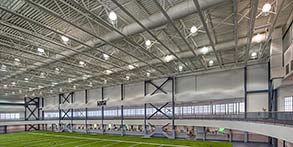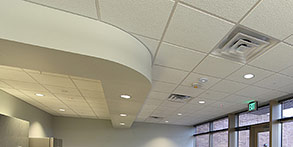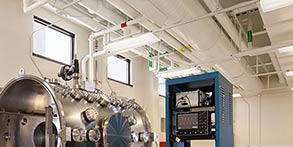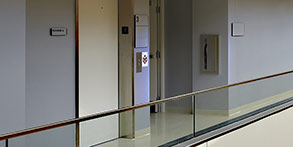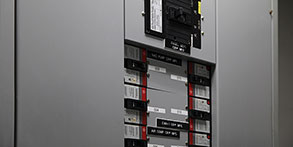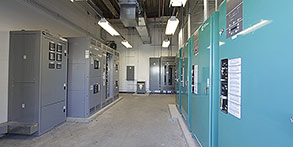- Fully coordinate mechanical, electrical, plumbing (MEP) and fire protection systems with each other and with the building structure, enclosure, thermal envelope and interior design.
- Ensure direct exterior access is provided (for CE) to main mechanical and electrical rooms.
- Screen exterior equipment from primary views (landscape, building masses, screen walls) and comply with AT requirements.
- Keep equipment away from main building entrances; locate service area/yard on least visible side of a building.
- Coordinate the location of all exterior meters, equipment and devices to provide convenient access and an overall coordinated and orderly appearance.
- Design emergency generator systems integrally with all other building systems and avoid incompatible building additions; locate generators near service areas and ensure they are not visible from primary entrances.
- When structure is exposed as a finished ceiling, fully integrate MEP and fire protection systems to provide an organized uncluttered appearance.
- Conceal ducts, piping, conduits, devices, etc., when permanent walls, suspended ceilings or raised floors are provided; locate sprinkler heads in orderly configuration.
- Limit interior wall-mounted equipment in occupied personnel spaces; avoid surface-mounted conduit and pipes.
- Provide efficient utility rooms with layouts to facilitate system performance and maintenance; provide convenient access to controls, clearly label systems and include operating and maintenance instructions.
- Separate mechanical and electrical and communications rooms.
- Integrate recessed and wall-mounted fixtures such as fire standpipe cabinets and drinking fountains within permanent walls.
Design high performance and sustainable buildings with efficient mechanical, electrical, plumbing (MEP) and fire protection systems coordinated into the overall design. Balance life-cycle cost, energy efficiency and occupant comfort with budgets and operational requirements.
Follow UFC 3-410-01 for HVAC system design requirements and criteria; it also establishes system efficiency requirements, cost effectiveness criteria and indoor temperature/humidity and ventilations requirements. Ensure maximum flexibility of systems.
Design complete MEP systems including materials, fixtures and equipment to safeguard health and property. Ensure systems provide economy and reliability. Provide simple, functional designs and systems.
Provide adequate and efficient exterior lighting to promote good visibility. Reduce glare and over-illumination by balancing the light level with surface reflectivity.
Meter all utilities for new facilities and major renovations. Comply with UFGS Sections 26 27 13.10 30, 26 27 14.00 20, 33 12 33.00 30, and 33 51 13.00 30.
Sustainability
Following UFC 1-200-02, evaluate site and building components to determine whether passive and natural design strategies and features are cost effectively incorporated before the active and mechanical systems are designed. Passive thermal comfort methods are allowed and encouraged when shown to be effective at maintaining required interior conditions/requirements and achieving lower life cycle cost than other methods.
Use a collaborative, integrated planning and design team, composed of user, government support staff and appropriate professionals to optimize energy performance and energy efficiency. Protect and conserve water for both indoor water and outdoor water following reduction strategies in UFC 1-200-02. The use of potable water for landscape irrigation is discouraged.
Implement renewable energy generation projects where life cycle cost effective and when there are no adverse effects on base wide electrical systems.
MEP systems should enhance indoor environmental quality and must meet thermal, humidity and ventilation requirements of UFC 3-410-01. Material specifications should include consideration of environmentally preferable products, products with recycled content, as well as low-emitting and biologically-based products.
Resilience
Following DoD and AF criteria analyze data related to documented risks and life-cycle cost effectively develop passive systems prior to the design of active mechanical systems when addressing increased heating or cooling requirements. Consider semi-passive or renewable energy systems, such as ground-source heat pump, to reduce energy use following a life-cycle cost analysis.
Address drought, desertification and ecosystem shifts with acceptable dust mitigation strategies for exterior and interior systems and equipment.
Appraise energy generation infrastructure, facilities, systems, and equipment and consider renewable energy technologies and energy savings performance contracts following AF guidance when upgrading, standardizing or replacing these. Eliminate single points of failure to critical assets or mission-critical facilities, such as by providing dual feed.
GeneralUFC 1-200-01 General Building Requirements https://www.wbdg.org/dod/ufc/ufc-1-200-01
UFC 1-200-02 High Performance and Sustainable Building Requirements https://www.wbdg.org/dod/ufc/ufc-1-200-02
UFC 3-400-02 Design: Engineering Weather Data https://www.wbdg.org/dod/ufc/ufc-3-400-02
USAF/DOE Design Guide for Military Family Housing - Energy Efficient Revitalization and New Construction https://www.wbdg.org/FFC/AF/AFDG/milfam.pdf
MechanicalUFC 3-410-01 Heating, Ventilating, and Air Conditioning Systems https://www.wbdg.org/dod/ufc/ufc-3-410-01
UFC 3-410-02 Direct Digital Control for HVAC and Other Building Control Systems https://www.wbdg.org/dod/ufc/ufc-3-410-02
UFC 3-410-04 Industrial Ventilation https://www.wbdg.org/dod/ufc/ufc-3-410-04
PlumbingUFC 3-420-01 Plumbing Systems https://www.wbdg.org/dod/ufc/ufc-3-420-01
UFC 3-440-01 Facility-Scale Renewable Energy Systems https://www.wbdg.org/dod/ufc/ufc-3-440-01
AFI 32-1067 Water and Fuel Systems https://static.e-publishing.af.mil/production/1/af_a4/publication/afi32-1061/afi32-1061.pdf
ElectricalUFC 3-501-01 Electrical Engineering https://www.wbdg.org/dod/ufc/ufc-3-501-01
AFI 32-1062 Electrical Power Plants and Generators https://static.e-publishing.af.mil/production/1/af_a4/publication/afi32-1062/afi32-1062.pdf
AFI 32-1064 Electrical Safe Practices https://webapp1.dlib.indiana.edu/virtual_disk_library/index.cgi/821003/FID577/pubs/af/32/afi32-1064/afi32-1064.pdf
Fire ProtectionUFC 3-600-01 Fire Protection Engineering for Facilities https://www.wbdg.org/dod/ufc/ufc-3-600-01
ETL 01-18 Fire Protection Engineering Criteria - Electronic Equipment Installations https://www.wbdg.org/FFC/AF/AFETL/etl_01_18.pdf
ETL 98-8 Fire Protection Engineering Criteria - Existing Aircraft Facilities https://www.wbdg.org/FFC/AF/AFETL/etl_98_8.pdf
ETL 95-1 Halon 1301 Management Planning Guidance https://www.wbdg.org/FFC/AF/AFETL/etl_95_1.pdf
ETL 94-6 Fire Protection Engineering Criteria and Technical Guidance - Removal of Halogenated Agent Fire Suppression Systems https://www.wbdg.org/FFC/AF/AFETL/etl_94_6.pdf
CommunicationsUFC 3-580-01 Telecommunications Interior Infrastructure Planning and Design https://www.wbdg.org/dod/ufc/ufc-3-580-01
